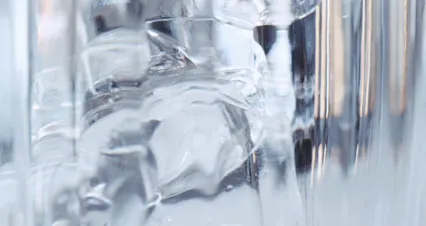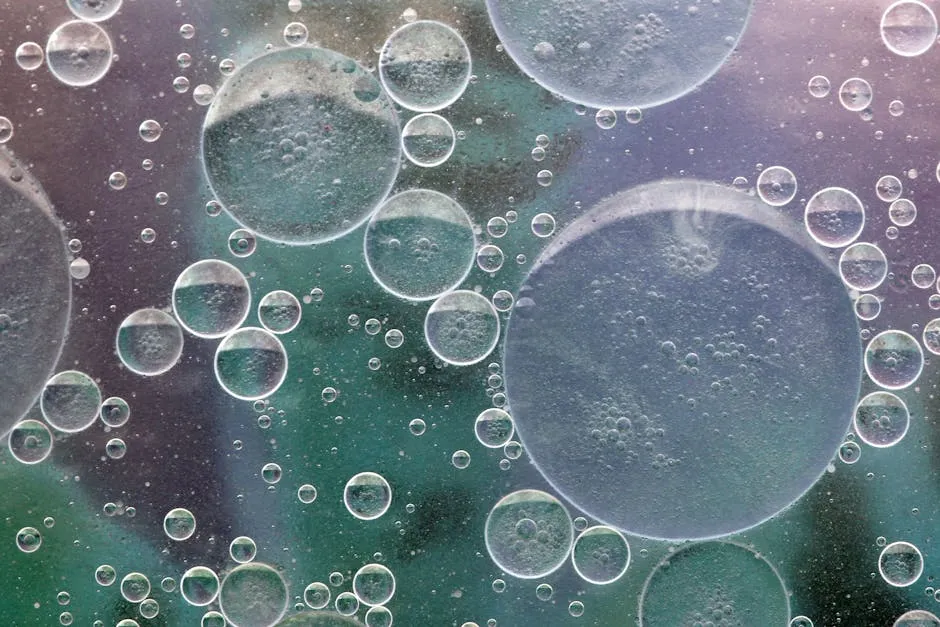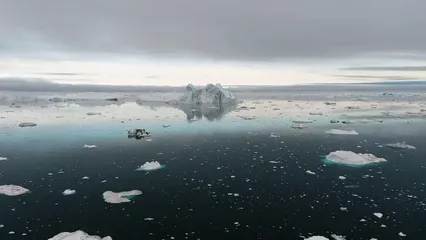
Why Do We Observe Different Ice Properties in Freshwater Versus Saltwater?
Introduction
Ice is fascinating, isn’t it? Whether it’s the ice cubes that cool your refreshing drink or the thick sheets blanketing a frozen lake, it plays a starring role in both our daily lives and the environment. But have you ever wondered why ice in freshwater appears so different from ice in saltwater? It’s a curious topic that invites a closer look.
Freshwater ice forms a smooth, clear layer, while saltwater ice often takes on a more porous and milky appearance. This difference isn’t just for show; it has significant implications for our planet and the ecosystems within it. Imagine this: you drop an ice cube into a glass of seawater. What happens? That ice cube floats differently than the one in your glass of tap water. Why is that?
The answer lies in the molecular magic of water. Ice is crucial for many reasons. From regulating temperatures in our environment to providing habitats for marine life, understanding ice properties helps us appreciate its role in nature. But here’s where the plot thickens: the presence of salt in water alters the freezing process. Saltwater freezes at a lower temperature than freshwater, which leads to intriguing differences in how the two types of ice behave.
As we look deeper into the science, we can’t help but ask: What secrets lie beneath the surface of these icy formations? Why does that ice cube in your salty seawater float differently than the one in your glass of fresh water? Buckle up, because we’re about to embark on an enlightening exploration of ice properties, salinity effects, and their broader implications for our planet!

Summary
In this blog post, we’ll uncover the intriguing differences between freshwater and saltwater ice. First, we’ll define the basic principles behind ice formation in both types of water. You’ll learn how salinity dramatically impacts freezing points and the resulting ice structures.
But that’s not all! These differences extend beyond mere appearances. They play a vital role in marine ecosystems and climate. The characteristics of ice affect heat retention in oceans, influencing weather patterns and the survival of aquatic life.
For instance, while freshwater ice tends to melt more quickly due to its structure, saltwater ice retains brine channels that affect melting rates differently. This leads to significant implications for sea life and climate regulation.
By the way, if you’re looking to keep your drinks cool during those summer parties, consider investing in a Silicone Ice Cube Tray. These molds not only create perfectly shaped ice but are also flexible, making it easy to pop out those cubes without any fuss.
So, get ready to dive into the science of ice! We’ll explore the molecular structures, the effects of salinity, and how all this knowledge can help us better understand our planet’s climate and ecosystems. By the end of this post, you’ll have a clearer picture of why these ice types differ and why it matters to our world.

The Basics of Ice
Water is a peculiar molecule. It has a unique molecular structure, consisting of two hydrogen atoms bonded to a single oxygen atom. This simple arrangement leads to fascinating behaviors, especially when water transitions from a liquid to a solid state—ice.
When water cools, the kinetic energy of its molecules decreases. As temperatures drop, water molecules slow down and begin forming hydrogen bonds. These bonds create a lattice-like structure, which is why ice has a crystalline form. The hydrogen bonds are responsible for holding the molecules in place, resulting in the solid structure of ice.
Interestingly, ice is less dense than liquid water. This density anomaly causes ice to float, allowing aquatic life to survive beneath the icy surface. Imagine a frozen lake in winter: the ice layer acts as insulation, preventing the water below from freezing solid. This property is vital for ecosystems, as it supports diverse aquatic habitats.
Speaking of ice, if you ever find yourself needing to clear your car windshield in the winter, you might want to check out a handy Ice Scraper for Car Windshields. It makes those frosty mornings a whole lot easier!

Freshwater Ice Formation
Freshwater ice exhibits distinct characteristics that set it apart. The freezing process begins when the temperature hits 0°C (32°F) under normal pressure conditions. As freshwater cools, it becomes denser until it reaches this freezing point.
Once the freezing process starts, water molecules arrange themselves into a tight, smooth structure. This results in clear, solid ice that can be quite stunning. The smooth surface of freshwater ice allows it to melt at a slower rate compared to its saltwater counterpart. Why? Because the tightly packed molecules minimize the formation of air pockets, which can trap heat and hasten melting.
When you think of freshwater ice, picture a picturesque frozen lake, glistening under the sun. This clear ice can be deceivingly strong, making it a popular spot for winter activities like ice fishing or skating, as long as thickness permits safety. And if you’re into ice fishing, don’t forget to grab some Ice Fishing Gear to make your experience more enjoyable!

Saltwater Ice Formation
Saltwater ice tells a different story. The freezing process in saltwater is influenced significantly by salinity. As salt dissolves in water, it lowers the freezing point, meaning saltwater freezes at temperatures below 0°C (32°F). This phenomenon is known as freezing point depression.
When seawater begins to freeze, the salt doesn’t just vanish; it gets pushed out of the ice. This creates a porous structure filled with brine channels—tiny passages that contain concentrated saltwater. These channels give saltwater ice a milky appearance, which is a stark contrast to the clear structure of freshwater ice.
The porous nature of saltwater ice affects its properties. It melts faster than freshwater ice due to the brine channels. When the ice melts, the salty water flows out, making it denser and causing the remaining ice to float on top. This unique structure plays a crucial role in marine ecosystems, as it influences the survival of various marine species and impacts ocean currents.

The Impact of Salinity on Ice Properties
Freezing Point Depression
When we throw salt into the mix, things get interesting, especially concerning ice formation. Salt lowers the freezing point of water, a phenomenon known as freezing point depression. Imagine trying to freeze your ice cream on a hot summer day. You’d need a much colder freezer if it’s loaded with toppings, right? Similarly, seawater, packed with salt, requires lower temperatures to freeze than its freshwater counterpart.
The science behind this principle is fascinating. Water molecules are polar, meaning they have a positive and negative end. When salt dissolves, it breaks into sodium and chloride ions. These ions get in the way of water molecules trying to bond. So, instead of forming a solid structure at 0°C (32°F), saltwater remains liquid at lower temperatures. For instance, seawater with a salinity of about 35 parts per thousand freezes at approximately -1.8°C (28.8°F). That’s a chilly twist!
Different ocean regions showcase this effect. In the Arctic, where the salinity can fluctuate, ice forms under varying conditions. For example, during freezing events, the brine is expelled from the forming ice, creating a briny slush that stays liquid even below 0°C. This unique characteristic is vital for marine ecosystems, influencing everything from ice thickness to the survival of marine creatures.
In essence, the presence of salt not only lowers the freezing point but also alters the entire freezing process. This contributes to the diverse properties of saltwater ice compared to freshwater ice, leading to implications for everything from climate dynamics to marine life survival. Understanding the importance of these ice properties is crucial for environmental science.
Understanding the role of ice and water is essential in environmental science. why is the study of ice and water important for environmental science

Ice Structure and Composition
Freshwater and saltwater ice may both look white and frosty, but they each have unique structural identities that set them apart. Imagine two ice cubes in your drink: one is a pristine, clear cube from your freezer, while the other is a milky, porous chunk from the ocean. What gives?
Freshwater ice forms a tight, crystalline structure. When water freezes, the molecules arrange themselves in a hexagonal lattice. This formation results in clear, smooth ice that reflects light beautifully. In fact, you can often see right through a thick sheet of freshwater ice. It’s like nature’s own glass.
In contrast, saltwater ice tells a different story. When seawater freezes, the salt does not integrate into the ice structure. Instead, it gets pushed out, leading to the formation of brine channels—tiny, interconnected pores filled with salty water. This is why saltwater ice often appears cloudy or milky. The structure is less uniform and more porous, resembling Swiss cheese.
These structural differences have significant implications. For one, freshwater ice is denser and tends to melt more slowly because it traps less air. The tightly packed molecules resist heat transfer, making it a sturdy layer on lakes and ponds. Conversely, saltwater ice, with its brine channels, melts faster because the salty water can’t hold onto the cold as effectively. The brine flows out, making the remaining ice less dense and more susceptible to melting.
Understanding these differences is crucial, especially for marine ecosystems. The unique properties of saltwater ice affect everything from habitat availability for seals and polar bears to the way ocean currents function. In a nutshell, while both types of ice have their own charm, their distinct structures significantly influence their physical properties and ecological roles.

Practical Implications of Ice Properties
Marine Ecosystems
Ice plays a vital role in marine ecosystems, acting as both a habitat and a climate regulator. The thickness and structure of ice can significantly impact marine life. Thick sea ice creates a solid platform for seals to rest and breed, while also providing a hunting ground. These frozen areas allow certain species to thrive, as they offer protection from predators and harsh weather.
Interestingly, the properties of sea ice also affect the organisms living beneath it. The porous nature of saltwater ice allows sunlight to penetrate, facilitating photosynthesis for algae and phytoplankton. This process forms the foundation of the food chain, supporting various marine species.
Moreover, sea ice acts as a temperature buffer. It insulates the ocean, preventing it from losing heat too rapidly. This, in turn, stabilizes the marine habitat, allowing fish and other aquatic creatures to flourish even in frigid waters. The melting of ice, however, disrupts this balance. As temperatures rise and ice diminishes, it alters habitats and threatens species that rely on stable ice conditions for survival.
And for those summer days, if you want to keep your drinks chilled, consider a stylish Stainless Steel Ice Bucket. It’s perfect for gatherings and adds a touch of elegance to your ice-cold beverages!
Weather and Climate Impact
The properties of ice have profound implications for weather patterns and climate on a global scale. Ice is integral to ocean currents, which play a critical role in regulating the Earth’s climate. These currents are driven by differences in water density, influenced by temperature and salinity. Ice formation in polar regions affects these dynamics significantly.
When sea ice forms, it expels salt, increasing the surrounding water’s salinity. This process alters the density of seawater, contributing to the ocean’s circulation patterns. These currents help distribute heat and nutrients worldwide, ensuring a balanced climate. Disruption in ice formation can lead to changes in these currents, potentially resulting in extreme weather events, such as droughts or heavy precipitation in various regions.
Moreover, the melting of ice due to climate change is a pressing concern. As ice retreats, it not only contributes to rising sea levels but also accelerates warming. This phenomenon is known as the albedo effect. With less ice to reflect sunlight, more heat is absorbed, exacerbating global warming.
Speaking of keeping cool, if you’re an ice cream lover, you might want to check out an Ice Cream Maker. It’s a delightful way to enjoy homemade ice cream anytime!
The significance of ice melting extends beyond immediate environmental changes. It impacts weather patterns, agricultural productivity, and even freshwater availability. Understanding the intricate relationship between ice properties and climate systems is crucial for predicting future scenarios and mitigating potential consequences.

Conclusion
Understanding the differences between freshwater and saltwater ice is no small feat. These distinctions stem from scientific principles that have far-reaching implications for our ecosystems and the climate. Let’s recap what we’ve uncovered in this frosty exploration.
First, we learned that freshwater ice forms at 0°C (32°F) under normal pressure. As water cools, its molecules slow down and bond into a tight, crystalline structure. This results in clear, smooth ice that floats gracefully atop water bodies. In contrast, saltwater ice has a lower freezing point due to the pesky presence of salt. Seawater, typically around 35 parts per thousand salinity, freezes at about -1.8°C (28.8°F). This creates a porous structure, leaving brine channels that can trap salty water within the ice.
The implications of these differences extend well beyond aesthetics. Freshwater ice, with its clear structure, tends to melt more slowly compared to its saltwater counterpart. The brine channels in saltwater ice promote quicker melting as they release saltwater into the surrounding environment, disrupting the ice’s stability. This melting behavior affects marine life, as many species rely on specific ice conditions for habitat and breeding.
Moreover, the broader environmental impact cannot be ignored. Ice plays a crucial role in climate regulation. Sea ice reflects sunlight, helping to stabilize ocean temperatures. When this ice melts, darker ocean water is exposed, leading to increased heat absorption and accelerating climate change. The melting of polar ice caps, driven by rising global temperatures, poses significant threats to coastal communities and ecosystems worldwide.
Now, let’s take a moment to reflect on our everyday encounters with ice and water. Have you ever noticed how ice cubes in your drink behave differently from those in the ocean? Next time you grab a cold beverage, consider the intriguing science behind the ice. Understanding these differences not only satisfies our curiosity but also highlights the interconnectedness of natural systems. So, as we ponder these icy phenomena, let’s appreciate the delicate balance of our planet’s ecosystems and the vital role ice plays within them.

FAQs
Please let us know what you think about our content by leaving a comment down below!
Thank you for reading till here 🙂
All images from Pexels




